Your Guide to Non-GMO Fruit Delivery: What It Means and Why It Matters
- By The FruitGuys
- Last Updated On
- Reading Time: 10 mins.
Here at The FruitGuys, we specialize in non-GMO fruit delivery and believe that GMOs (genetically modified organisms) should be labeled—but we also want to bring you the facts about them, not just the worries. So, we spoke to both GMO fruit developers and GMO labeling advocates to help you understand what GMOs are, how they became part of our food system, how they’re regulated, and what their pros and cons might be for you, local farmers, and the planet.
This is a comprehensive guide, so feel free to skip to the section that interests you most. If you’re buckling up for the full ride (which we hope you are!), let’s start with the basics.
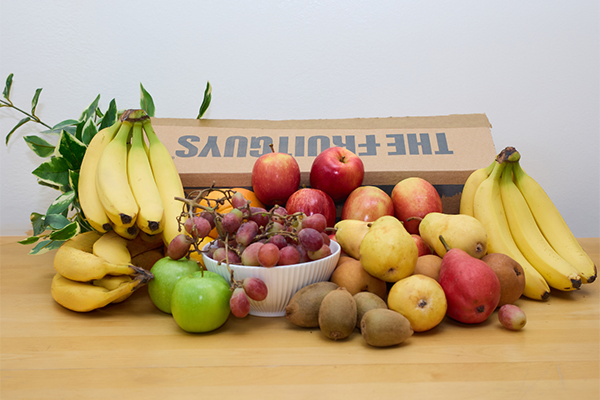
What Are Non-GMO Fruits?
Non-GMO fruits are fruits that are not genetically modified. In other words, they’re regular old fruits. Non-GMOs appear spontaneously in nature, but plant experts can also create them by crossing two related fruits in a natural process called hybridization. (More on that in a moment.)
GMO fruits are fruits that are genetically modified. Here’s the official definition of the term “GMO”* from the United States Environmental Protection Agency (EPA):
“A GMO is a plant, animal, or microorganism that has had its genetic material (DNA) changed using technology that generally involves the specific modification of DNA, including the transfer of specific DNA from one organism to another. Scientists often refer to this process as genetic engineering.”
Scientists choose to genetically modify fruits and other foods for a variety of reasons. A few common goals are increasing yields, making plants resistant to diseases, or adding extra nutrition.
*It’s important to note that “GMO” has started to go out of style. In more recent regulations, you might see the terms “genetically engineered” (GE) or “bioengineered” (BE) instead.
Understanding GMOs vs. Hybrids
Hybridization and genetic modification often have the same goals: Both processes can help amplify beneficial traits in fruits and remove unhelpful ones. But GMOs and hybrids are different.
Hybrid fruits can occur naturally when two different varieties of fruit cross to create something new. Grapefruit, for example, is a natural hybrid of sweet orange and pummelo. Plant experts can replicate this process by crossing two related fruits to create a new one with traits they prefer. A famous example is the pluot, a cross between a plum and an apricot.
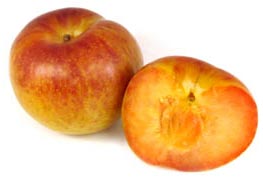
GMO fruits can’t occur naturally. By definition, scientists create them by modifying the DNA of a particular fruit. This can include altering, removing, or adding genetic material. Any new genes can come from related fruits or unrelated plants, animals, or bacteria with beneficial traits.
If you want to learn more, check out our deeper dive on GMOs versus hybrids.
A Quick History of GMO Fruits
GMO produce has been on the market in America for more than thirty years. The Flavr Savr tomato, engineered for a longer shelf life, was the first to be approved in 1994. A handful of other fruits and vegetables followed, including Rainbow and SunUp papayas in 1997. They’re formulated to resist the papaya ringspot virus and are often credited with saving the Hawaiian papaya industry. (The United States Department of Agriculture, or USDA, says that today, “Papaya produced in the United States should be presumed to be BE [bioengineered] papaya.”)
Arctic® apples—which scientists engineered not to brown by turning off one of the apple’s own genes—hit the market in 2018. Now, Arctic® apples come in three varieties: Arctic® Granny, Arctic® Golden, and Arctic® Fuji, with three additional varieties on the way. Pink pineapples made it to market in 2020. They’re engineered to have bright pink flesh and an extra dose of the antioxidant lycopene.
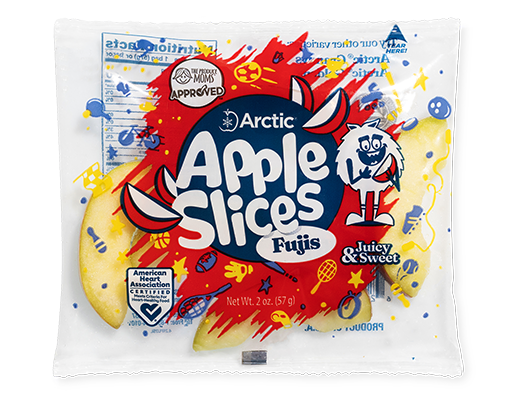
Last but not least, The Purple Tomato™ earned its approval in 2022. It has bright purple skin and flesh and high levels of anti-inflammatory pigments, thanks to genetic material from the Snapdragon flower. More GMO fruits, like non-browning bananas, are also in the works around the world.
Are GMO Fruits Safe to Eat?
The USDA says that “GMO foods are as healthful and safe to eat as their non-GMO counterparts.” A 2016 report from the National Academies of Science, Bioengineering, and Medicine backs this up. After reviewing twenty years of data, its writers found “no substantiated evidence of a difference in risks to human health between current commercially available genetically engineered crops and conventionally bred crops.” They also reported no conclusive causal evidence of environmental problems tied to genetically modified crops.
Some GMO advocates say certain GMOs are actually healthier for you than their non-GMO counterparts. Nathan Pumplin, the CEO of Norfolk Healthy Produce, which developed the GMO The Purple Tomato™, told The FruitGuys that it has bonus health benefits.

“Purple fruits and vegetables, like blueberries, have a unique kind of beneficial antioxidant. Most of us don’t eat enough of these foods! Tomatoes are a staple in so many diets, and we saw an opportunity to enrich a food people already love with beneficial compounds called anthocyanins, which have been linked to reduced inflammation and better health outcomes,” he said.
Despite the USDA’s verdict on GMOs, a spokesperson for the Non-GMO Project (an interest group that advocates for GMO labeling) told The FruitGuys that they’re still concerned about safety. They worry that GMOs may be safety tested in a biased or outdated way.
How GMO Safety Testing Works
The United States Food and Drug Administration (FDA), EPA, and USDA work together to regulate bioengineered plants and animals. They assess the safety of GMOs for humans, animals, plants, and the environment in a joint effort called The Coordinated Framework.
To get more insight into this process, The FruitGuys spoke to Sarah Davidson Evanega, the vice president of business development at Okanagan Specialty Fruits, the company responsible for developing the GMO Arctic® apple. Evanega has a PhD in Plant Biology from Cornell University, where she completed a dissertation on GMO papaya.

“You submit your dossier of data—showing what you did, how you did it, and that it isn’t going to have any impact on the health of people or the environment, including animals in the environment. That packet is submitted to the relevant agencies, which could include the FDA, EPA, and USDA. They do their own review guided by their in-house technical experts. In our case, our USDA approval comes first, allowing us to grow the crop, harvest the fruit, and submit health data that the FDA uses to make their determination,” Evanega explained.
The FDA’s approval process for GMO plants relies heavily on collaboration with the companies that develop them, which a spokesperson for the Non-GMO Project told The FruitGuys is “a conflict of interest.” GMO developers can choose whether or not to opt into the initial phase of the FDA’s Plant Biotechnology Consultation Program. In the final phase, they complete their own safety and regulatory assessments and submit summaries to the FDA for evaluation. At that point, the FDA flags any unresolved issues and works with the developer to fix them.
“When all safety and regulatory issues are resolved, the FDA concludes the consultation with a letter to the plant developer,” the FDA website reads. “The letter explains that FDA has no questions about the developer’s safety and regulatory assessment and reminds the developer that they remain legally obligated to ensure the safety of the food products they bring to market.”
Evanega told The FruitGuys that although the process is collaborative, it’s still thorough.
“Other non-GMO breeding methods used to develop crops, such as mutagenesis, are not subject to regulation. GMOs are probably the most studied crops in our food system. They’re absolutely scrutinized for their safety,” she said.
Evanega also added that regulations provide a level of security to consumers, and it’s in GMO product developers’ best interest to comply.
“We want to deliver on our commitment to consumers to be transparent and develop products that are good for people and the planet,” she said.
The Benefits of GMO Produce
Now that you know a bit more about what GMO fruits are, their history, and how they’re tested, let’s dig deeper into the pros and cons of GMO produce overall—starting with the positive stuff. Here are a few benefits that The FruitGuys heard from Pumplin, Evanega, and beyond.
Disease Resistance
Genetic modification can make plants resistant to specific diseases that kill crops and hurt farmers’ livelihoods. The Rainbow and SunUp papayas, as we mentioned before, are resistant to the papaya ringspot virus and helped revive papaya farming in Hawaii. GMO summer squash and potatoes were also developed for disease resistance.
Herbicide Tolerance
Crops can be modified to tolerate herbicides, which means farmers can spray for weeds without worrying about killing their crops, too. This trait is common in GMO corn, cotton, soybeans, alfalfa, canola, and sugar beets.

Insect Resistance
Crops can also be modified to create their own pesticides, so that farmers don’t need to spray pesticides as intensively to control insects in the fields. Since 1996, cotton and corn farmers have planted GMOs with genetic material from the bacteria Bacillus thuringiensis. Those genes make the corn and cotton plants poisonous to specific pests (although some bugs are now evolving resistance).
Enhanced Nutrition
For years, scientists have modified staple crops like rice, corn, and wheat to make them healthier and help fight malnutrition in developing countries. Golden Rice, for example, is genetically modified to have extra beta carotene in its grains. The Purple Tomato™ also falls into this category because its Snapdragon genetics give it an antioxidant boost.
Food Waste Reduction
GMO Arctic® apples and potatoes are designed to resist browning, the unpleasant color that appears after they’re sliced. Browned apples and potatoes are safe to eat, but people often throw them away because of their color. Eliminating browning can help reduce that food waste.
Concerns About GMO Produce
Now that we’ve covered the benefits of GMO produce, let’s consider a few of the concerns farmers and interest groups like the Non-GMO Project have about them.
Crop Contamination
Pollen from GMO crops can blow into nearby farm fields and public spaces, potentially cross-pollinating with non-GMO plants. This can cause problems for farmers who want to export their crops or label them certified organic. Certified organic farmers aren’t allowed to grow GMO crops, and although the USDA allows for some genetic drift, they have to take steps to prevent GMO contamination.
Increased Pesticide Use
GMOs can contribute to either reducing or increasing pesticide use. As we explained previously, some GMO crops reduce the use of insecticides by making the crops themselves resistant to pests. But other GMO crops are designed to survive herbicide sprays. In the latter case, farmers may spray more, which can pollute the environment and encourage the evolution of pesticide-resistant insects and weeds.
Loss of Biodiversity and Resilience
GMO crops with desirable traits like high yields and pest resistance are popular with farmers. In fact, 90% of the corn, soy, and cotton grown in the US are now GMOs. This has raised concerns that too many farmers will use the same GMO seeds. That monoculture planting could hurt biodiversity and the resilience of our food system if a disease or pest slips through the GMO’s defenses. (This is also a concern with non-GMO monocultures.)
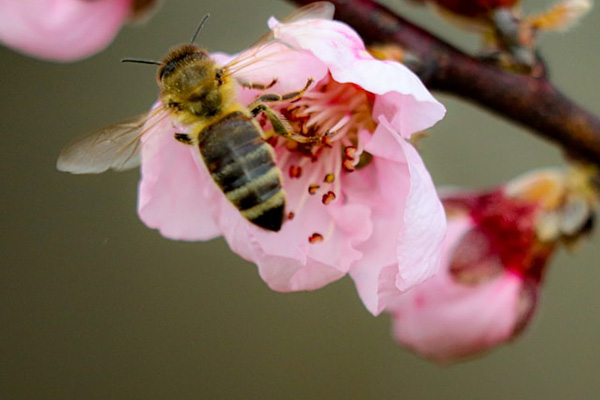
Lack of Transparency
For decades, people ate GMOs without realizing it. Neither GMO produce nor products that use GMO ingredients needed to carry a label. However, this changed on January 1, 2022, when the National Bioengineered Food Disclosure Standard (NBFDS) created by the National Bioengineered Food Disclosure Law went into effect.
The NBFDS “requires food manufacturers, importers, and certain retailers to ensure bioengineered foods are appropriately disclosed” with labeling options like text and symbols. However, the labels don’t cover all GMO foods, and they use the term “bioengineered” rather than the more commonly used term “GMO,” which can confuse shoppers.
Want to learn more about the NBFDS, how it works, and what to look for? Check out our blog “How Do You Know If a Fruit Is GMO? Look for the BE Label.”
Rapid Technological Changes
Scientists are continually exploring new methods of genetic modification that didn’t exist when the first GMOs reached the US market. As recently as 2020, for example, Emmanuelle Charpentier and Jennifer A. Doudna won the Nobel Prize in Chemistry for their discovery of the CRISPR/Cas9 genetic scissors. Because of such advances, The Non-GMO Project feels that “testing protocols are insufficient to assess the impacts of increased exposure and complexity.”
Why The FruitGuys Is Committed to Non-GMO Fruit Delivery
Here at The FruitGuys, we believe that our customers deserve to understand and feel good about what they’re eating. We also value biodiversity, farmer autonomy, and a resilient food system. That’s why we’re committed to 100% non-GMO fruit delivery.
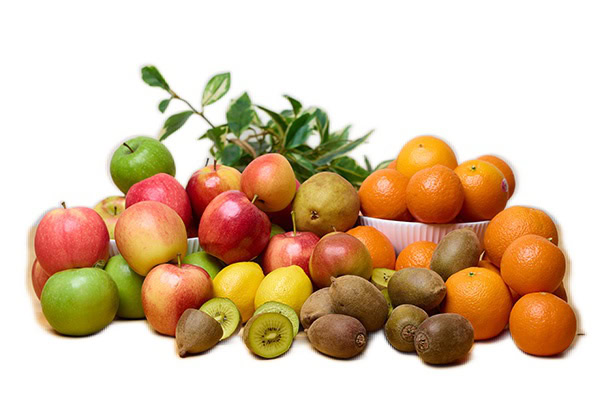
We don’t purchase any GMO fruits or vegetables for our conventional or organic boxes, and we support GMO labeling rules. Sourcing non-GMO snacks is a bit more complicated, but we’re proud to work with snack partners like Rule Breaker Snacks, The GFB, and Amäzi that offer Non-GMO Project Verified options for our snack mixes.
Ultimately, there are so many delicious and healthy non-GMO foods out there that we don’t see a need to include GMOs in our produce boxes, especially when our customers may have concerns about them. We’re happy to celebrate nature’s bounty instead!
FAQs
1. How do I know if a fruit is GMO?
If you want to find out if a fruit is GMO, look for the “bioengineered” or “derived from bioengineering” label. You can also check the USDA’s list of bioengineered foods or use the resources at the bottom of this blog post. The easiest way to avoid GMO fruit is by purchasing organic produce from a USDA Organic certified farmer or a USDA Organic certified handler like The FruitGuys.
2. Are GMO fruits still healthy?
According to the USDA, GMO fruits are just as healthy as non-GMO fruits. To get the most health benefits, we recommend eating a wide variety of fresh, seasonal fruit—GMO or non-GMO.
3. What is the difference between organic fruit and GMO fruit?
Organic fruit is fruit grown with organic practices. GMO fruit is fruit that’s genetically modified. Organic farmers aren’t allowed to plant GMO seeds, so by definition, fruit that’s certified organic can’t be GMO.
4. Why choose non-GMO fruit delivery?
Non-GMO fruit delivery is great for anyone concerned about the potential negative impacts of GMOs. If you’re an office manager or work in HR, choosing non-GMO fruit delivery for your workplace can give your employees peace of mind.
Recent Articles
Win Free Snacks for Celebrating National Fruit at Work Day
2025 Employee Gift Ideas: Fruit Gift Hampers and More
How Managing Less Helps Employees Take the Lead
Why Employee Appreciation Gifts Matter in 2025
Healthy Employee Appreciation Gift Ideas for Workplace Wellness
Subscribe to our Newsletter
"*" indicates required fields



